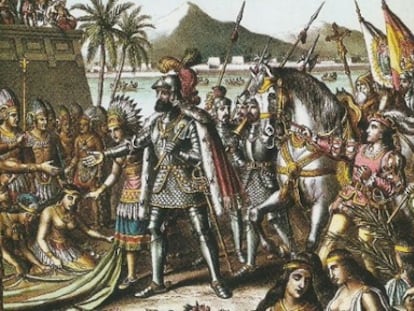Has the tomb of the first historian of the Americas been discovered?
Despite having been forgotten by history, Gonzalo Fern¨¢ndez Oviedo played a key role in the conquest
This beginning of this story could have been lifted out of a host of mystery films or novels: a group of men are working at a religious building that is centuries old, and, by chance, when they remove a layer of soil, they discover a crypt, covered in rubble and lost to the sands of time. But this is no fictional tale.

The story dates back to 1992, when work was going on to transfer the pantheon where Christopher Columbus was buried from the cathedral of Santo Domingo, the capital of the Dominican Republic. The project was part of the many acts staged that year to commemorate the mariner¡¯s arrival in the Americas five centuries earlier. But unexpectedly, another tomb was discovered.
A few meters below the Italian mariner¡¯s mausoleum was the crypt with a damaged brick vaulted ceiling measuring 8.46 meters by 3.80 meters. Who was the undoubtedly illustrious person buried in such a prized spot?
Oviedo¡¯s skull should show his injuries from a knife fight with another Spaniard during his time in the Americas
Esteban Prieto Vicioso, head of conservation at the Basilica Cathedral of Santa Mar¨ªa la Menor, to give the church its full name, says the evidence points to Gonzalo Fern¨¢ndez de Oviedo, a name as overlooked as it is important. He is attributed with writing the first account of the Americas, on the orders of Charles V, the Holy Roman Emperor. Until his death in 1557 at the age of 80, Fern¨¢ndez de Oviedo wrote about Columbus¡¯s first voyage to the Americas in 1492 and up to Pizarro¡¯s rebellion in 1549, as well as detailing the geography, plants, animals and peoples of the continent.
¡°We know that up to the middle of the 16th century there was an altar dedicated to Santa Luc¨ªa built on Oviedo¡¯s instructions, and that right underneath he ordered a vault to be constructed, where he was buried,¡±?says Prieto Vicioso. ¡°There is no documentary evidence that his body was ever moved from there.¡±
The restoration team at the cathedral ¨C the first one built in the Americas ¨C is trying to raise money to excavate the crypt, which they hope will allow them to identify Oviedo. They believe they will find an iron key in the tomb to the fortress of Santo Domingo, of which Oviedo was governor for the last 25 years of his life. A final detail they believe will definitively establish that the tomb is Oviedo¡¯s would be damage to the skull, which was the result of a knife fight with another Spaniard that took place in the Dari¨¦n Gap, in what is today Panama.
Oviedo¡¯s works on the first years of the Spanish colonization of the Americas are still studied by scholars today
Despite having been largely forgotten by historians, Gonzalo Fern¨¢ndez Oviedo played a key role in the conquest of the Americas, as well as the reconquest of Spain: he accompanied the Catholic Monarchs when they entered Granada on January 6, 1492 after the defeat of the last Moorish kingdom in Spain; he was also present the following year when Columbus met Isabel and Ferdinand on the return from his first voyage to the Americas.
He then moved to Italy, where he met Leonardo da Vinci and leading members of the Borgia family, which originated from Spain, such as Pope Alexander VI and his daughter Lucrecia. He later became secretary of Gonzalo Fern¨¢ndez de C¨®rdoba, a leading navigator. He made his first trip to the Americas in 1514, as part of the expedition led by Pedrarias D¨¢vila and was witness to the former¡¯s rivalry with Vasco N¨²?ez de Balboa, the first European to reach the Pacific via the Americas, and who would be executed by D¨¢vila in 1519.
Oviedo returned to Spain in 1526, where he published his Summary of the Natural History of the Indies, which was an immediate success, was translated into English, French, and Italian, and which is still studied by scholars to this day.
In 1532, Charles V named him Official Chronicler of the Indies and Governor of the Fortress of Santo Domingo. He spent the rest of his life in Santo Domingo in a small house filled with books on the banks of the Ozama River, which runs through the capital, writing to governors and servants of the crown throughout Spain¡¯s vast American empire, and meeting with them when they stopped off on the island. His research was channeled into A General and Natural History of the Indies, the first part of which was published in 1535, although the remaining two volumes did not appear until the middle of the 19th century.
English version by Nick Lyne.
Tu suscripci¨®n se est¨¢ usando en otro dispositivo
?Quieres a?adir otro usuario a tu suscripci¨®n?
Si contin¨²as leyendo en este dispositivo, no se podr¨¢ leer en el otro.
FlechaTu suscripci¨®n se est¨¢ usando en otro dispositivo y solo puedes acceder a EL PA?S desde un dispositivo a la vez.
Si quieres compartir tu cuenta, cambia tu suscripci¨®n a la modalidad Premium, as¨ª podr¨¢s a?adir otro usuario. Cada uno acceder¨¢ con su propia cuenta de email, lo que os permitir¨¢ personalizar vuestra experiencia en EL PA?S.
En el caso de no saber qui¨¦n est¨¢ usando tu cuenta, te recomendamos cambiar tu contrase?a aqu¨ª.
Si decides continuar compartiendo tu cuenta, este mensaje se mostrar¨¢ en tu dispositivo y en el de la otra persona que est¨¢ usando tu cuenta de forma indefinida, afectando a tu experiencia de lectura. Puedes consultar aqu¨ª los t¨¦rminos y condiciones de la suscripci¨®n digital.










































